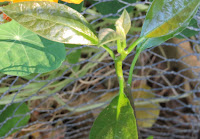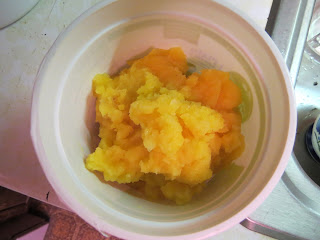Dear Folks,
There are many discussions on drying herbs and other foods. It is the perfect way to preserve many kinds of foods for long term storage and later use.
Herbs in particular present a couple of unique challenges.
1) Flavor and Aroma, and
2) Color
One need only look at a dried leaf from a tree to understand the color issue. Dead and dried the leaf is brown, tan or white.
The other, far more important, issue is the flavor and aroma of the herb when dried. After all that is the point of preserving herbs. You want that full amount (or as much as possible) of the essential oils to flavor your food and entice you and your family to dinner.
Some herb essential oils are more sensitive to heat. Thin leafed varieties such as cilantro or parsley don't hold up to cooking or heat as well. The stems of parsley can used to make chicken soup for instance, but if you want to add the leaves the general instructions usually say to add at the last.
TIP: Whenever you are using herbs in cooking, add half for the cooking process and add the other half just before serving.
Back to drying. Check the internet and the recommendations will be: Hang to dry in the kitchen or a dry place; dry in the microwave, or oven (on low); use an electric dehydrator; or the sun.
My preferred method of drying herbs is in the refrigerator.
You may have purchased "freeze-dried" herbs like chives at the store.
Freeze-Drying is NOT using the freezer.
Freeze-Drying refers to rapidly removing the moisture from the air at a low (above freezing) temperature to preserve the food.
Our modern refrigerators do this quite nicely, although not at the level of commercial units. I'm sure you have forgotten something in the frig which was open, only to be discovered later as a "dried" whatever-it-used-to-be.
Credit the constant removal of excess moisture in your refrigerator for this result.
Freeze drying herbs does two wonderful things to your herbs: it maintains most or all of the color AND it keeps those wonderful essential oils, thus the flavor and aroma, more intact.
Over the years, after using paper towels or paper plates in various locations (depending on where I had room) for drying the herbs, I finally hit on an upper shelf which is over the meat/cheese keeper drawer and the exact length of cooling racks. Perfect!! Now I can dry two levels of herbs, with or without the paper towels (I use the paper if the leaves are small so they do not drop through).
[Pictured: Chervil on the left, parsley on the right. In the jars already is dill on the left and cilantro on the right.]
Process:
1) Pick the herbs after the sun has been on them for at least an hour, and after any dew has dried off.
DON"T pick on a cool, damp, overcast morning. The essential oils re-treat in the cold making the herb less flavorful and can even make them taste awful. Picking them after the sun has been on them means all those wonderful oils are now at their peak in the leaves.
2) Rinse well to get dust and any critters off them. Spin dry or shake very well.
3) DO NOT CHOP - you will dry (and store) them whole, stems and all. This keeps the flavor and aroma more intact.
When you go to use the dried herbs later, crushing those dried leaves will immediately tell you the flavor is still there.
4) Spread out on a tray, paper towel or plate and label with the herb and date. You will use that information later when you package up the dried herbs.
5) Expect the process to take 1-3 weeks or so depending on how thick the leaves are and how much you are drying. If you are drying a large bunch, turn and rotate as needed to expose all surfaces.
To PREVENT mold the herbs must be perfectly dry before storing in jars.
6) When finished, put in jars with as little crushing as possible to preserve those great flavors. Label and store in your cool, dry, dark pantry. Try to keep them away from the stove where the heat and light can reduce the lifespan of all that flavor.
7) What about the
stems? The stems make great flavoring options for soups, stews and stirfrys. Just bundle together while cooking, and remove before serving, as you would a bay leaf.
Dried mint stems make nice stirrers for coffee, hot chocolate or tea.
You could certainly use ziplock bags, but I prefer to use jars which can be reused over and over again.
You can dry vegetables in the same way. If you have a bumper crop of carrots, peppers, onions and garlic they can all be dried, after being rinsed and chopped up. It tickles me no end to go into MY pantry to get some dried garlic for use, garlic I grew and dried.
HOW LONG will these last? I have dried Oreganos and Stevia, and more that are over 2 years old and are as fragrant (and tasty) as the day I stored them. A rule of thumb for any dried herb or spice is 6 - 12 months. Go by taste and scent. If you stored and dried them properly they do not go bad, they just start to loose them "oomph" requiring more to achieve the same flavoring.
My BACKUP drying method is our wonderful, intense sun.
[Pictured: My red onion harvest, chopped and on the trays and then fully dried - they can shrink quite a bit.]
Any day the air temperatures are going to be in the mid-80s or higher with a clear bright sun, is a good day to dry in the sun. I use the sun drying for large volumes of herbs or vegetables. Although it would be great to have a refrigerator dedicated to drying, that is not going to happen :-) So the sun helps me out.
I have a set of electric dehydrator trays (Only no motor) I picked up at a yard sale some years ago to expand the amount of drying space.
Place your rinsed herbs or chopped vegetables on trays, lined with aluminum foil or parchment paper (metal trays helps the drying process), and place in the sun. Cover lightly with either paper towels or one of those picnic net covers. Depending on how much you are drying it may take more than 1 day. BUT bring in the trays at night to keep the food from reabsorbing moisture.

You can even get creative with your drying. Dry several herbs together, in small amounts. When they are finished drying, crush together to form your own blend. SMALL amounts means you will use these blends up before the crushed herbs loose their oomph.

Taking the combination possibilities one step further dried, celery, carrots, onions, bell pepper, and herbs together to create my own salt-free vegetable bouillon, which turned out so awesome I which I had the ability to send you a sniff of it! I used my spice grinder to get it down to a nice coarse powder.
Read up on my prior post on
sun drying here
And how I sun dried my
Roselle here..
AND last but not least -- if you have enjoyed
"kale chips" or other leafy green dried chips, they are easily made in the sun. Rinse, tear into pieces, toss with just the tiniest bit of oil, sprinkle of salt (Parmesan cheese if you like) spread out on a tray in the sun and when dried you have wonderful chips (which you will probably devour in about 2 minutes like I did!).
Actually that was not the last -- I have also made
crackers in the sun. Nice to have the sun do some 'cooking' instead of heating up the house with the oven.
Lemon/Rosemary Seed Crackers
1 cup sunflower seeds, ground
2 tablespoons golden flax seeds, ground*
2 tablespoons seasame seeds, leave whole
1/2 teaspoon salt
1/3 cup finely shredded Monterey Jack Cheese
1 tablespoon crushed dried rosemary (if using fresh use 2-3 tablespoons finely chopped)
Zest of 1 lemon
1/2 cup of juice from the lemon (but you may not need all of it).
*Gold flax seeds are milder in flavor than the regular
I have a bullet grinder but you can use any kind of grinder you need to grind the seeds if not already ground.
Put all the dry ingredients in a bowl and stir, add cheese, stir again,
then add lemon juice a little at a time until you have a moist but not
soggy "mash" and mix well so everything is moistened.
Spread on aluminum foil, silpat or parchment paper. Cover with a piece
of wax paper and roll out to even depth - about 1/8 - 1/4 inch, and even
up the sides a bit by squaring off. Use a long straight blade to score (or pizza wheel) -
you don't have to cut all the way through - it just makes it easier to
break up after they cool.
Place in the sun. You may need to flip them to ensure drying all the way. These are ADDICTIVE!
I hope this gives you some great ideas for preserving your bounty to enjoy later on. One of the great things about gardening in the Desert is we can grow, use and store all through the year, following our seasonal harvests. We don't have to jam it all in at one crazed time in the fall.
If you like posts, please share.
You can also like
my facebook page.
Have a great day in the garden and kitchen!
-- Catherine, The Herb Lady
P.S. Links for purchasing my books and calendars are on the sidebar here on the blog.
If you enjoyed this post, subscribe below by entering your email, to get all my posts!
Disclaimer: Clicking on links on this blog may earn me a small commission if you purchase something. Your price does not change.



















































